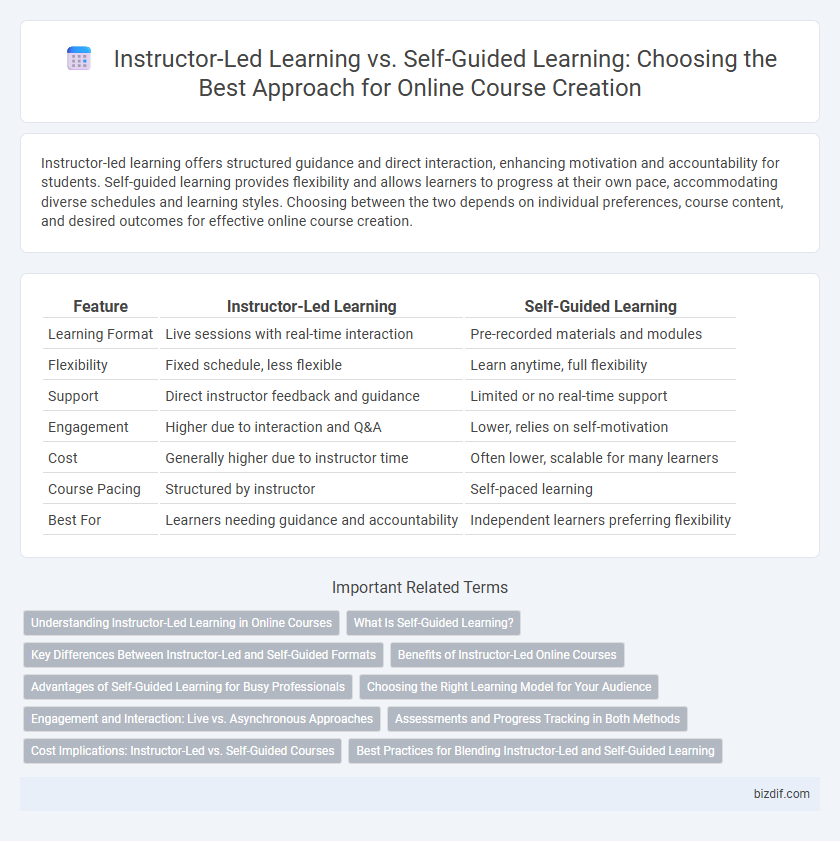Instructor-led learning offers structured guidance and direct interaction, enhancing motivation and accountability for students. Self-guided learning provides flexibility and allows learners to progress at their own pace, accommodating diverse schedules and learning styles. Choosing between the two depends on individual preferences, course content, and desired outcomes for effective online course creation.
Table of Comparison
| Feature | Instructor-Led Learning | Self-Guided Learning |
|---|---|---|
| Learning Format | Live sessions with real-time interaction | Pre-recorded materials and modules |
| Flexibility | Fixed schedule, less flexible | Learn anytime, full flexibility |
| Support | Direct instructor feedback and guidance | Limited or no real-time support |
| Engagement | Higher due to interaction and Q&A | Lower, relies on self-motivation |
| Cost | Generally higher due to instructor time | Often lower, scalable for many learners |
| Course Pacing | Structured by instructor | Self-paced learning |
| Best For | Learners needing guidance and accountability | Independent learners preferring flexibility |
Understanding Instructor-Led Learning in Online Courses
Instructor-led learning in online courses involves real-time interaction between instructors and students, enabling immediate feedback and personalized guidance. This model fosters higher engagement and accountability through scheduled sessions, which can improve knowledge retention and skill acquisition. Compared to self-guided learning, instructor-led courses often incorporate live discussions, assessments, and collaborative activities that enhance the overall educational experience.
What Is Self-Guided Learning?
Self-guided learning in online course creation empowers learners to control their pace and focus areas, enabling personalized knowledge acquisition. This approach relies on curated resources, interactive content, and assessments designed to foster independence without real-time instructor intervention. Platforms supporting self-guided learning typically include progress tracking, adaptive quizzes, and forums to enhance engagement and retention.
Key Differences Between Instructor-Led and Self-Guided Formats
Instructor-led learning offers real-time interaction and personalized feedback from experts, enhancing engagement and immediate clarification of complex topics. Self-guided learning provides flexibility and pace customization, allowing learners to access diverse materials anytime, which benefits time management and individual preferences. Key differences include structured schedules and collaborative opportunities in instructor-led formats versus autonomy and self-motivation requirements in self-guided courses.
Benefits of Instructor-Led Online Courses
Instructor-led online courses provide real-time interaction with experienced educators, enhancing personalized feedback and immediate clarification of complex topics. These courses foster a structured learning environment that improves motivation and accountability through scheduled sessions and peer engagement. Access to live discussions and collaborative exercises boosts comprehension and retention, making instructor-led formats ideal for learners seeking active guidance.
Advantages of Self-Guided Learning for Busy Professionals
Self-guided learning offers busy professionals unparalleled flexibility, allowing them to access course materials at their convenience without the constraints of fixed schedules. It enhances personalized pacing, enabling learners to spend more time on challenging topics while advancing quickly through familiar content. This autonomy supports better retention and application of knowledge, making skill development efficient amidst demanding work commitments.
Choosing the Right Learning Model for Your Audience
Selecting the right learning model for your audience hinges on understanding their preferences and needs; instructor-led learning offers structured, real-time interaction ideal for learners seeking guidance and immediate feedback. Self-guided learning provides flexibility and autonomy, catering to individuals who prioritize pacing and scheduling convenience. Analyzing audience demographics, engagement levels, and learning objectives ensures the chosen model maximizes retention and course effectiveness.
Engagement and Interaction: Live vs. Asynchronous Approaches
Instructor-led learning fosters real-time engagement and dynamic interaction through live discussions, Q&A sessions, and immediate feedback, enhancing learner motivation and comprehension. Self-guided learning offers flexibility with asynchronous content that allows learners to progress at their own pace, though it often lacks instant interaction and may reduce opportunities for collaborative learning. Balancing live instructor presence with interactive tools in online course creation can optimize learner engagement and accommodate diverse learning preferences.
Assessments and Progress Tracking in Both Methods
Instructor-led learning features structured assessments and real-time progress tracking through instructor feedback and scheduled evaluations, enhancing accountability and targeted improvement. Self-guided learning relies on automated quizzes, self-assessments, and digital dashboards to monitor progress, fostering flexibility but requiring high learner self-discipline. Both methods employ Learning Management Systems (LMS) with assessment analytics, yet instructor-led courses typically offer more personalized progress reports and adaptive feedback mechanisms.
Cost Implications: Instructor-Led vs. Self-Guided Courses
Instructor-led learning often incurs higher costs due to expenses related to instructor salaries, scheduling, and real-time interaction management, making it less budget-friendly for large-scale implementations. Self-guided courses significantly reduce financial barriers by eliminating the need for live instruction and allowing learners to progress at their own pace, optimizing resource allocation. Organizations seeking cost-effective training solutions frequently prefer self-guided formats to maximize scalability and minimize ongoing operational expenses.
Best Practices for Blending Instructor-Led and Self-Guided Learning
Blending instructor-led and self-guided learning optimizes engagement and knowledge retention by combining real-time feedback with flexible study pacing. Best practices include structuring self-guided modules to reinforce concepts introduced during live sessions and integrating interactive assessments that adapt to learner progress. Leveraging technology platforms with analytics capabilities enables continuous monitoring and personalized support, enhancing overall course effectiveness.
Instructor-led learning vs Self-guided learning Infographic

 bizdif.com
bizdif.com